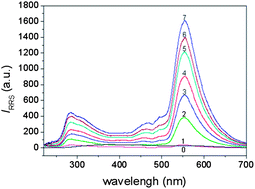A scattering method is developed to determine trace amounts of heparin. Under optimal conditions, a ternary complex is formed via the interaction of anionic heparin and the cationic coordination compound [CoL]2+, which is formed between Co(II) and 4-[(5-chloro-2-pyridyl)azo]-1,3-diammobenzene (5-Cl-PADAB). As a result, new characteristic resonance Rayleigh scattering (RRS) peaks are located at 280 nm and 550 nm, and the RRS signal is enhanced greatly. The scattering intensity at 550 nm is in proportion to the heparin concentration over the range of 0.05–1.60 μg mL−1, with the corresponding limits of determination (3σ) of 1.3 ng mL−1. The method is simple, feasible and can be successfully used to detect heparin in real samples.

